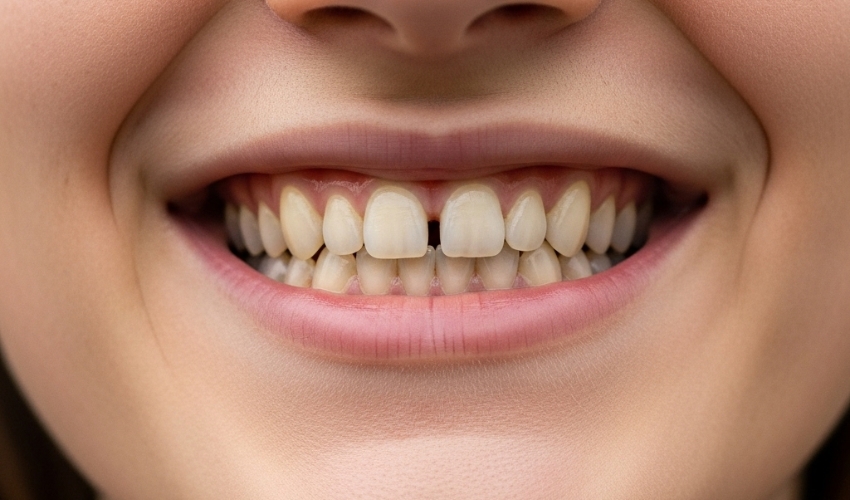Book An Appointment

Have you ever noticed a small space between someone’s front teeth—or maybe in your smile? That space is called a diastema. While many people may view it as a cosmetic quirk or even a cultural beauty mark, others might feel self-conscious about it. Fortunately, modern dentistry offers several effective ways to close or improve the appearance of diastemas.
In this article, we’ll explore what diastemas are, who they typically affect, the treatment options available, and when to see a dentist to address them.
What Is a Diastema?
A diastema refers to a gap or space between two teeth, most commonly seen between the upper front teeth (central incisors). These gaps can vary in size and may affect both the front and back teeth. Although a diastema isn’t necessarily a health issue, it can have aesthetic and functional implications.
There are several reasons why a diastema might occur, including:
- Genetics: If your family members have gaps, you’re more likely to have them too.
- Jaw and Teeth Size Discrepancy: If the teeth are too small for the jawbone, gaps may appear.
- Frenulum Attachment: A thick or improperly positioned labial frenulum (the tissue that connects the upper lip to the gums) can push the teeth apart.
- Habits: Childhood habits, such as thumb-sucking or tongue thrusting, can lead to spacing issues.
- Gum Disease: Advanced gum disease can result in bone loss around the teeth, causing shifting and gaps.
- Tooth Loss or Small Teeth: Missing teeth or teeth that are naturally small may lead to adjacent teeth drifting apart.
Is Diastema Common?
Yes, diastemas are relatively common, especially in children. According to the American Dental Association, nearly 50% of children under 6 will have some form of spacing between their teeth; however, many cases self-correct as the permanent teeth erupt. In adults, the prevalence is lower, but diastemas can still occur and persist without treatment.
Who Does Diastema Affect?
Diastema can affect people of all ages, although its causes and implications may differ among age groups.
Children
In children, diastemas are often temporary. The gap typically closes naturally as more permanent teeth erupt and the mouth continues to grow. However, persistent gaps beyond the age of 10–12 may require professional evaluation.
Adults
For adults, diastemas are less likely to resolve on their own. A persistent gap can impact:
- Self-confidence: Many individuals feel less comfortable smiling or speaking.
- Speech: Large gaps may lead to speech impediments or a lisp.
- Bite function: Gaps may affect how the teeth align when biting and chewing.
- Oral health: Spaces may lead to food trapping, increasing the risk of cavities and gum issues.
Genetics and Ethnicity
Some studies suggest a genetic predisposition to diastemas, particularly among certain ethnic groups. For example, diastemas are more common in individuals of African descent due to variations in jaw and tooth proportions.
What Are Treatment Options for Diastema?
Fortunately, several effective treatments are available to correct diastemas. The ideal treatment depends on the cause, the size of the gap, and the patient’s aesthetic goals. Here are the most common solutions offered by a dentist:
1. Orthodontic Treatment (Braces or Clear Aligners)
Traditional Braces and Invisalign are excellent options for gradually moving teeth into the correct positions. Orthodontic treatment is highly effective for addressing larger gaps or cases that involve additional alignment issues.
Benefits: Long-lasting, corrects bite problems
Treatment Time: Several months to a couple of years
2. Dental Bonding
In this minimally invasive procedure, a tooth-colored resin is applied to the teeth to close small gaps. Dental bonding is a fast and relatively affordable procedure.
Benefits: Quick fix, natural look, no anesthesia required
Treatment Time: Typically completed in a single visit
3. Veneers
Porcelain or composite veneers are custom-made shells bonded to the front of teeth. They can effectively close gaps while improving shape and color.
Benefits: Aesthetic upgrade, durable, stain-resistant
Treatment Time: 2–3 visits
4. Frenectomy
If an oversized labial frenulum causes the gap, a minor surgical procedure called a frenectomy can help close it. After the frenectomy, orthodontic treatment may be needed to close the gap.
Benefits: Addresses the root cause of the gap
Treatment Time: Quick outpatient procedure
5. Dental Crowns
For cases involving significant tooth size discrepancies or damaged teeth, dental crowns may be used to close gaps and restore function.
Benefits: Protects damaged teeth while closing the gap
Treatment Time: Usually two visits
6. Dental Implants or Bridges
When missing teeth, dental implants or bridges can help restore both function and aesthetics.
Benefits: Permanent tooth replacement, maintains bone health
Treatment Time: Several months, depending on healing time
We provide comprehensive solutions to correct diastemas, whether you’re seeking cosmetic improvement or complete restorative treatment.
When to See a Dentist
You should see a dentist if you notice a diastema that:
- Persists beyond early childhood
- Appears suddenly or is growing larger
- Causes discomfort or affects speech
- Traps food and leads to frequent gum irritation
- Makes you self-conscious about your smile
Early evaluation by a trusted dentist in Charlotte NC can help determine the underlying cause and offer appropriate treatment options. In many cases, addressing the gap sooner rather than later can prevent more complex dental issues in the future.
Why Choose Professional Dental Care?
While some people turn to DIY methods, such as using rubber bands or “gap bands” seen on social media, these are not only ineffective but also potentially harmful. According to the American Association of Orthodontists, such methods can damage the gums and roots, potentially leading to tooth loss.
Professional dental treatment ensures that:
- The root cause of the diastema is identified
- You receive a personalized treatment plan
- The outcome is safe, durable, and aesthetically pleasing
Final Thoughts: Embrace or Fix Your Diastema—The Choice is Yours
Diastemas can be a unique feature that adds character to your smile, or something you’d prefer to correct for health or cosmetic reasons. Either way, understanding the causes and available treatments empowers you to make the best decision for your oral health.
If you’re unsure what steps to take, schedule a consultation with a dentist in Charlotte NC. Whether you’re looking for orthodontics, bonding, veneers, or a complete smile makeover, professional guidance makes all the difference.
Let your smile reflect how confident you feel. If a diastema is holding you back, remember that modern dentistry offers safe, effective, and attractive solutions.






